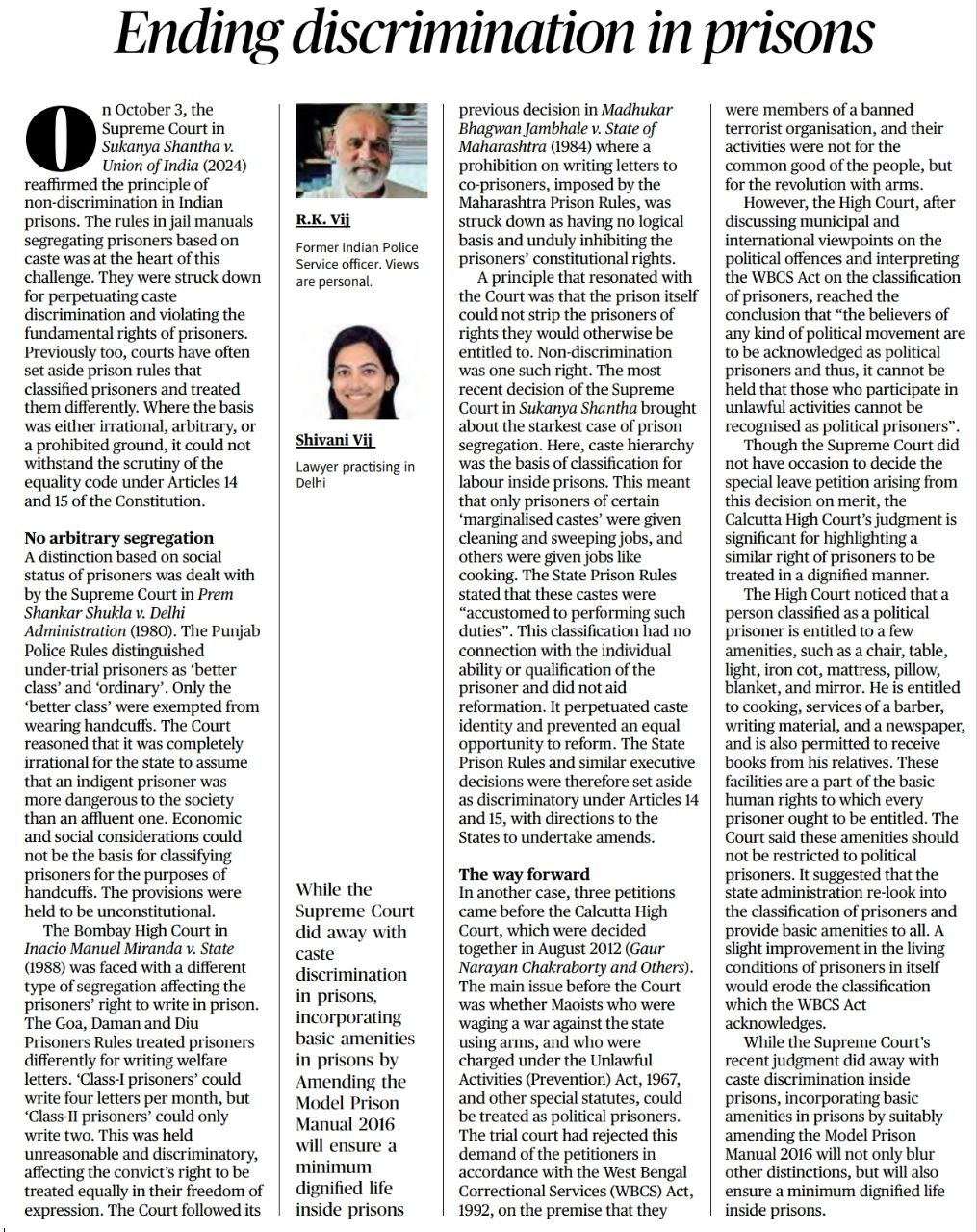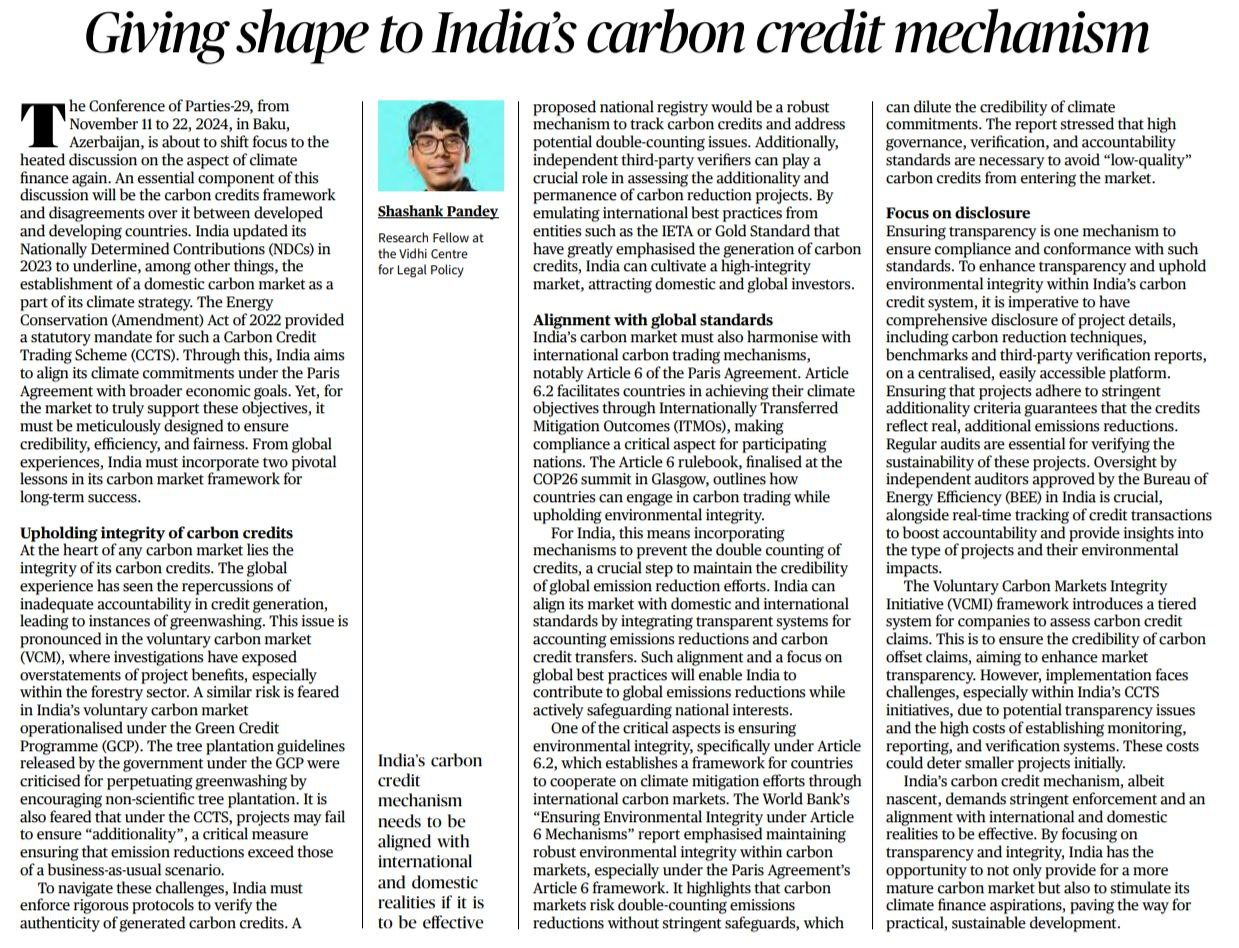1. Ending Discrimination in Prisons: A Step Toward Equality
Introduction:
The recent ruling by the Supreme Court of India in the case of Sukanya Shanta v. Union of India (2024) reaffirmed the principle of non-discrimination in prisons, striking down outdated and arbitrary segregation practices that perpetuated caste-based discrimination. This landmark judgment emphasized the protection of fundamental rights under Articles 14 and 15 of the Indian Constitution, promoting equality in the treatment of prisoners.
Key Points:
- Abolition of Caste-Based Segregation in Prisons:
- The Supreme Court judgment specifically addressed the rules in prison manuals that segregated prisoners based on caste.
- Previous practices treated prisoners differently based on arbitrary classifications, often infringing on their basic human rights.
- The court ruled that such discrimination violates constitutional provisions under Articles 14 (Right to Equality) and 15 (Prohibition of Discrimination).
- Historical Background:
- Prem Shankar Shukla v. Delhi Administration (1980): Challenged classification of prisoners as ‘better class’ and ‘ordinary,’ declaring it unconstitutional to exempt certain prisoners from wearing handcuffs.
- Inacio Manuel Miranda v. State of Goa, Daman and Diu (1988): Addressed the issue of prisoners’ rights to write letters. Rules that allowed ‘Class-I’ prisoners more writing privileges were found to be discriminatory.
- Principle of Non-Discrimination:
- The ruling emphasized that prisons should not strip prisoners of the rights to which they are entitled. The decision extended to eliminating classification based on caste or any other arbitrary distinction.
- The Court also highlighted that any form of segregation that impedes the right to equality or is not based on security reasons violates prisoners’ fundamental rights.
- Role of Model Prison Manual 2016:
- The manual emphasizes providing a minimum standard of amenities for all prisoners, preventing discrimination.
- The Supreme Court advocated for uniform application of these rules, ensuring dignity and equality for prisoners irrespective of caste or class.
- State Prison Rules and Unlawful Segregation:
- Many discriminatory provisions in State Prison Rules, such as the distinction between prisoners based on their caste and assigned duties like cleaning, were deemed unconstitutional.
- In some instances, the court discussed how political prisoners were unfairly denied basic amenities, violating the standards for dignified treatment.
Way Forward:
The ruling signifies a step forward in ensuring equality in prison administration and sets a precedent for future reforms. The court’s judgment encourages States to re-examine and amend outdated prison rules, bringing them in line with constitutional values. By expanding the scope of the Model Prison Manual, the court promotes the standardization of prison conditions across India to ensure that discrimination, in all forms, is eradicated from the system.
Conclusion:
The Supreme Court’s ruling in Sukanya Shanta v. Union of India marks a pivotal moment in the fight against caste-based and arbitrary discrimination in Indian prisons. The decision underscores the importance of safeguarding the fundamental rights of all prisoners, ensuring equal treatment, and upholding their dignity. As States move forward to implement these reforms, the judgment serves as a crucial reminder that the principles of equality and non-discrimination must prevail within the criminal justice system.
Mains Practice Question: |
Q. Discuss the significance of the Supreme Court’s recent judgment on ending caste-based segregation in Indian prisons. How does it reinforce the constitutional mandate of equality and non-discrimination? What are the challenges in implementing such reforms at the state level? |
2. Shaping India's Carbon Credit Mechanism: Aligning with Global Standards
Introduction:
As the world turns its focus to the 29th Conference of Parties (COP-29) in Baku, Azerbaijan (November 2024), one of the key areas of discussion will be the carbon credits framework.
India has emphasized the establishment of a robust domestic carbon credit market as part of its climate strategy, reflected in the updates to its Nationally Determined Contributions (NDCs) under the Paris Agreement.
This push, mandated by the Energy Conservation (Amendment) Act of 2022, aims to create a reliable and globally aligned Carbon Credit Trading Scheme (CCTS) to achieve India’s climate goals.
Key Points:
- Upholding the Integrity of Carbon Credits:
- Ensuring the credibility and effectiveness of India’s carbon credit mechanism is crucial. Past global experiences, especially with the voluntary carbon market (VCM), have shown that inadequate verification can lead to greenwashing.
- India must avoid similar pitfalls by enforcing stricter regulations for verifying the authenticity of carbon credits. This includes ensuring “additionality”—that the carbon credits represent real, measurable, and verifiable emission reductions beyond business-as-usual scenarios.
- Challenges with Greenwashing and GCP:
- In the past, India’s Green Credit Programme (GCP) has faced criticism for encouraging practices like non-scientific tree plantations, raising concerns over superficial solutions that do not contribute significantly to climate mitigation.
- Ensuring that projects under CCTS go beyond mere surface-level efforts and provide genuine environmental benefits is essential for the credibility of India’s market.
- Global Standards and Alignment:
- India’s carbon credit system must align with global mechanisms such as the Internationally Transferred Mitigation Outcomes (ITMOs) under Article 6 of the Paris Agreement.
- Global best practices from organizations like the International Emissions Trading Association (IETA) and the Gold Standard stress the importance of tracking carbon credits and preventing double-counting. Incorporating such frameworks can help India build a carbon market that is both internationally recognized and trusted by investors
- Focus on Disclosure and Transparency:
- Comprehensive disclosure mechanisms are necessary to ensure compliance. This includes regular audits, third-party verification, and making project-related data publicly available.
- Transparency will play a key role in preventing the circulation of low-quality carbon credits that could undermine climate goals.
- India can draw from global initiatives like the Voluntary Carbon Markets Integrity Initiative (VCMI), which outlines standards for claims and aims to increase market transparency.
Way Forward:
To build an effective carbon credit system, India must:
- Adopt rigorous methods for verifying carbon credits.
- Align domestic frameworks with international standards to gain global credibility.
- Promote transparency by providing clear project benchmarks and regular audits.
- Continue focusing on the environmental integrity of projects to prevent greenwashing.
While establishing this framework may require significant investment and oversight, doing so will enable India to contribute meaningfully to global emissions reduction efforts, both domestically and in international carbon markets.
Conclusion:
India’s emerging carbon credit market has the potential to become a crucial tool in achieving its climate commitments. By aligning with global standards and focusing on transparency and credibility, India can ensure the long-term success of its carbon credit mechanism. This will not only drive emissions reductions domestically but also position India as a key player in the global carbon market.
Mains Practice Question: |
Q. India’s carbon credit mechanism is in its nascent stages. Discuss the steps needed to align it with international standards to ensure transparency and avoid greenwashing. How can India overcome the challenges of establishing a credible carbon market?
|



